Barack Obama served as President from Jan 2009 – Jan 2017. When Obama came to office in Jan 2009, the US economy was in a deep recession, with falling real GDP, high unemployment and rising levels of government borrowing.
As President, Obama oversaw a moderate fiscal expansion which helped to promote economic recovery and falling unemployment. Given the depth of the 2009 recession, some argue the recovery was relatively weak. But, compared to the Eurozone, the US economy performed relatively well, with unemployment falling to pre-recession levels. However, despite a prolonged economic recovery, the US recovery was unevenly distributed. Median wages barely rose, and this compares to a booming stock market and rising corporate profit levels.
In evaluating the economic success of a president, it is worth bearing in mind many factors influence the economy beyond a President’s control. These include; trends in the global economy, long-term structural changes, Monetary Policy by the Federal Reserve and investment by private enterprise.
Economic statistics of Obama years
Real GDP
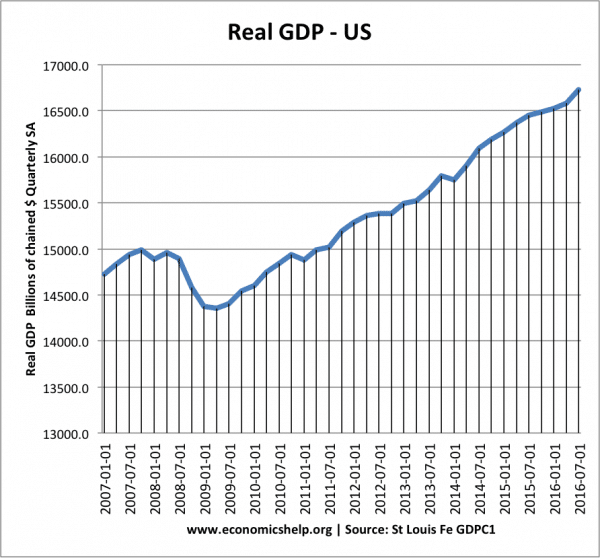
Economic growth
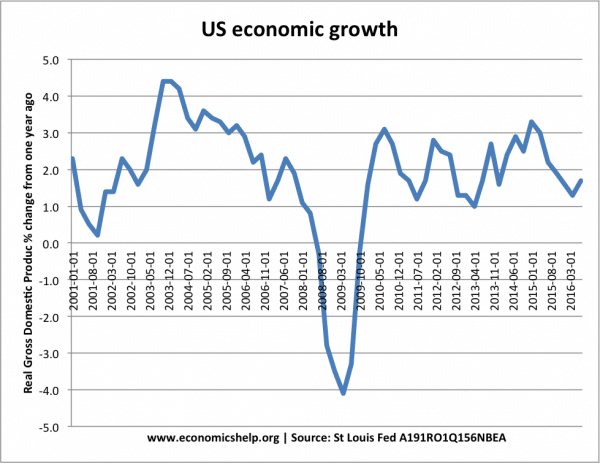
In 2009, shortly after coming to office, Obama passed a bill American Recovery and Reinvestment Act of 2009 – which involved $831 billion of economic stimulus – including tax cuts, unemployment benefits and infrastructure spending.
This recovery package played a role in boosting economic growth, though it also coincided with a global economic recovery and a loosening of monetary policy. Still, the OECD credits faster growth in the US compared to Europe was due to US stimulus and European austerity. (CNN link)
The stimulus bill was criticised by some for increasing the budget deficit. Others, such as Paul Krugman criticised the stimulus bill for being inadequate and too small – given the level of spare capacity in the US economy.
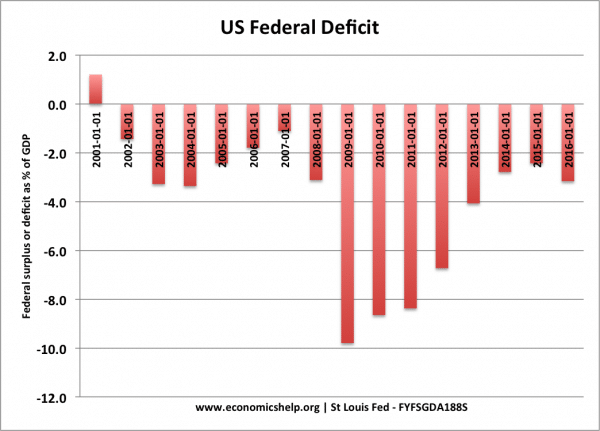
The stimulus of 2009 contributed to high levels of Federal borrowing, though, it is worth bearing in mind, the borrowing was also significantly increased by cyclical factors – e.g. lower tax revenues in the recession.
However, economic growth during 2010-16 helped the Federal deficit to shrink to 3% of GDP by 2016.
Public sector debt has been stabilised
Some analysts feared that the stimulus package and higher borrowing would increase borrowing costs and lead to rising bond yields. However, bond yields fell during the period 2010-16, suggesting there was no crowding out, but, in fact, there was a high demand for buying US government bonds.
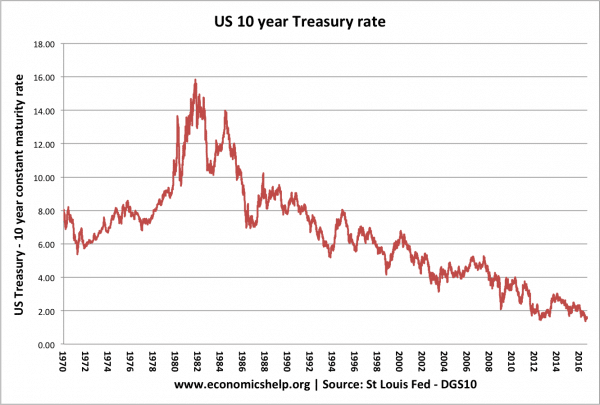
US bond yields declined to record levels; this reduced the cost of financing Federal borrowing.
Unemployment
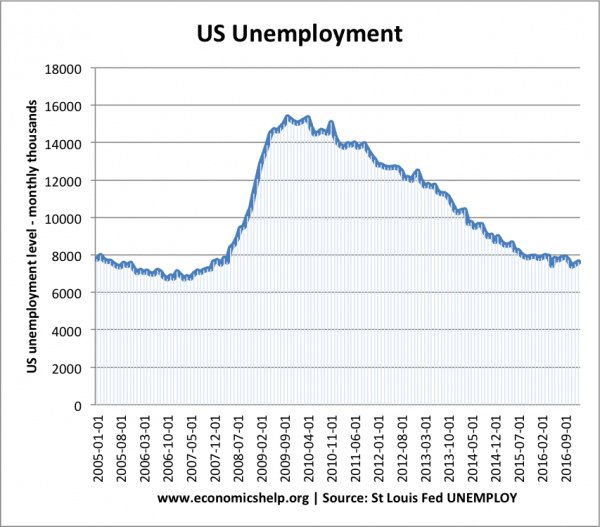
One of the strongest features of the US economy in 2010-16 was the relatively rapid decline in unemployment and the corresponding rise in employment levels. This mirrors a similar employment pattern in the UK, which also saw rapid fall in unemployment; however, it contrasts to the Eurozone where unemployment stayed stubbornly high.
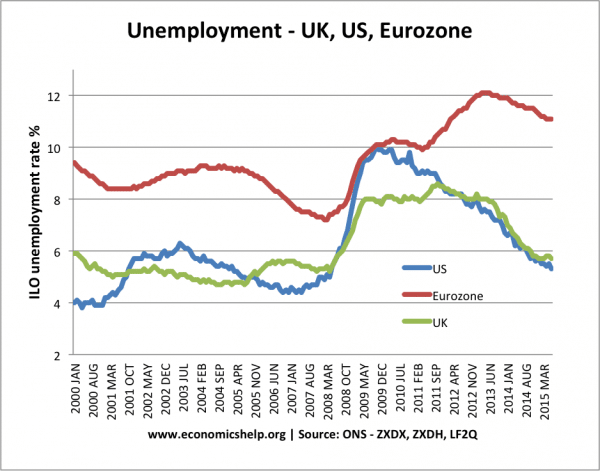
US unemployment fell quicker than Eurozone unemployment. This suggests the US responded more effectively to the Great Recession of 2009. Though, at least partly, it may be due to more flexible labour markets in US and UK – than in the Eurozone.
Real wages
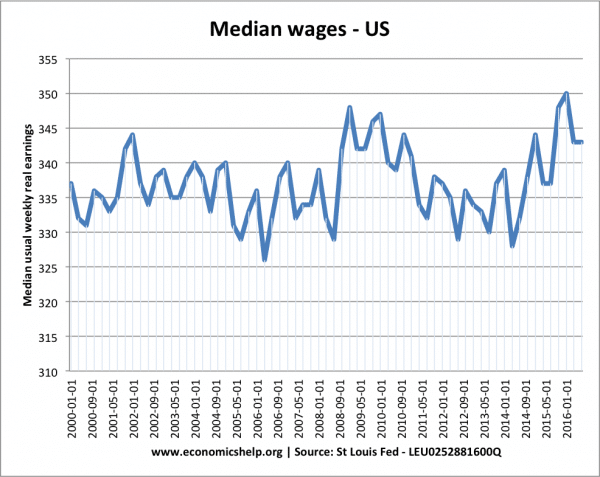
Despite the relatively rapid decline in unemployment, there has been concern about the quality of new jobs. (another feature of the UK recovery) In particular, median wages have been relatively stagnant in the period 2007-16. In other words, ordinary workers have not benefitted from the economic growth as much as companies and the higher paid.
Since the Minimum Wage was last set in July 2009, at $7.25 per hour, the US federal minimum wage has declined in real terms. The US minimum wage is relatively low compared to median wages.
There are many reasons for this low wage growth – factors, such as automation, increased competitiveness due to globalisation, a decline in trades unions and a rise in monopsony power of employers.
Manufacturing output
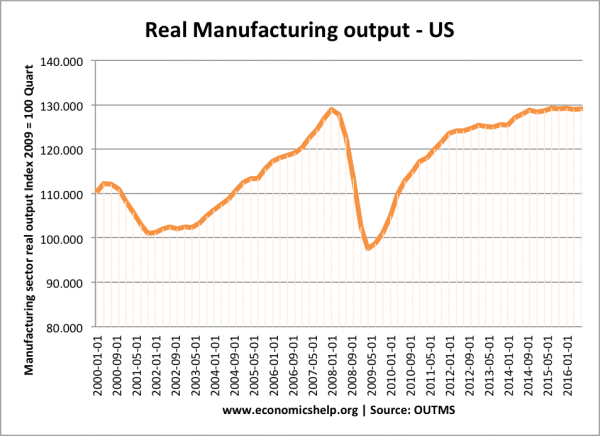
There has been increased scrutiny of the US manufacturing sector in recent years. Since 2009, US manufacturing saw a sharp rebound (from a very deep recession) However, since 2012, manufacturing output has stagnated, struggling to transcend the previous peak of 2007.
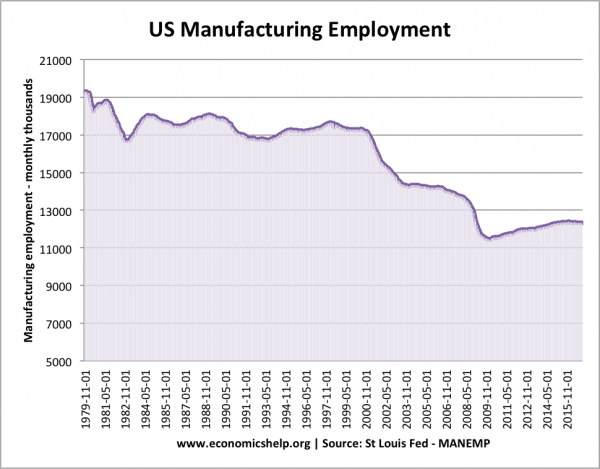
Manufacturing employment staged a small recovery from 11 million to over 12 million employed at the start of 2016. However, this graph illustrates the long-term decline of US manufacturing employment, which has occurred over the past couple of decades.
A signature policy of Obama was the automobile bailout package. Controversially, he authorised a major bailout of GM and Chrysler who were at risk of bankruptcy. The automobile bailout has generally been considered a success with both companies successfully turning around their business. Without the bailout, there would have been significant job losses in the automobile and related industries.
US inflation
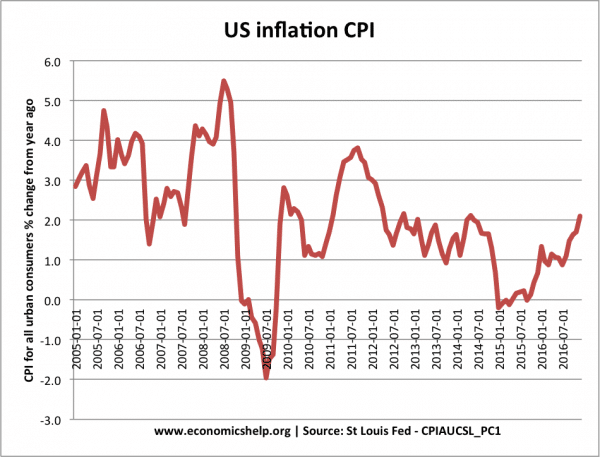
US inflation has remained low, with some periods of cost-push inflation in 2011.
Conclusion
Given the state of the economy in 2009, the economic performance of the Obama years could easily have been worse. Compared to similar economies, the US economy was relatively strong – with an impressive decline in unemployment and reasonably strong economic growth. Despite fears over the economic stimulus package, there were no adverse consequences – there was no inflationary impact or rising bond yields. It compares well compared the relative austerity of Europe.
Despite the impressive figures of GDP and unemployment, many workers have not felt much of a recovery in their wages and job security. New jobs are increasingly in the new flexible ‘gig economy’ which give firms greater flexibility but offers lower wages and greater insecurity to workers. Also, the challenges of rapid technological change and increased automation of manufacturing processes have led to profound changes in the US labour market, which have led to higher inequality and insecurity.
In Obama’s defence, it is difficult for a President to overcome these global technological and structural developments, which are almost unstoppable. Given low wage growth and greater job insecurity, the most effective way to improve living standards for the low paid is probably to extend welfare support – such as free health care – rather than try to return to the days of 17 million people working in US manufacturing. In this regard, Obama health care offers some improved living standards for the previously uninsured.
Related

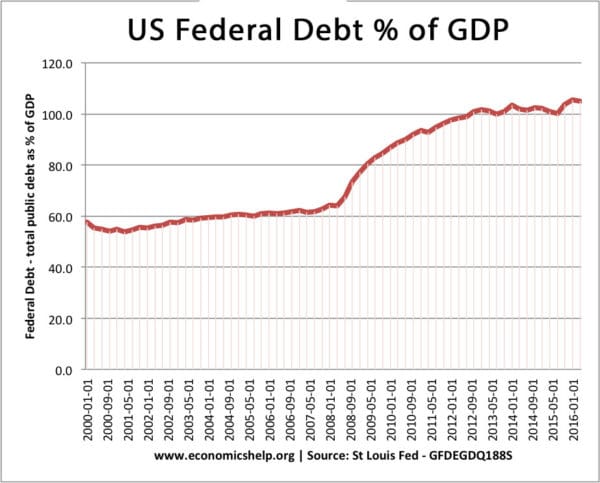
i feel obama’s term was intresting
Donald Trump inherited a good economy from former President Obama. Trump is bragging how good the economy is like he did it all by himself. Trump is riding on Obama’s shirttail trying to keep up. Trump does not care about anyone but himself. He is the worst president this country has ever had.
Like everything else in his pathetic life, T-Rump inherited a good, stable economy from President Obama. Yet, he has the gall to say he is responsible for jobs, lower taxes (for the wealthy), etc. Hopefully he won’t bankrupt America like he did (4X) after inheriting 40 million from ‘daddy’ who, by the way, brought Jr. an out from serving in Vietnam. Worst president and also a draft-dodging chicken sh!t.
This article paints the Obama economy really nice how cherry-picking stats work and lying with statistics! Final point is: one of the worst economic recovery in history- Barack Hussein obama
There is even a video with his own worst saying in other words, a magic wand was needed to make a good economy as a overall, it’s called: Obama magic wand speech- blaze tv
Not true. In Obama’s term there was no salary increase, but economic recovery from the economic crises of 2008 cannot be denied ! You have to be very ignorant or very interested in damaging Obama’s image… I don’t know which one is the case here, but you trying to change history does not change reality!
They fail to mention Bush started the stimulas in 2008 and created TARP.
I dont really understand why they want to give Obama all the credit when he was the beneficiary of programs that started before he took office.
All he did was follow Bushes lead.
Had to get that “Hussein” name in there right? The Dems always have to clean up after every Republican administration has almost ruined the country with recessions, unbalanced budgets, huge deficits and debt and now the disastrous Trump cult has left us with the highest debt in history, worst economy in decades and a pandemic which could have been limited if Trump didn’t call it a hoax and fire Obama’s pandemic team. PATHETIC.
You do know that Obama doubled our debt in his eight years, right? From a little over 10 trillion to almost 20 trillion. Worst economy in decades? Please show or even tells us where we would see those numbers. I’ll go look at them to see if you’re correct. You do remember who started the whole housing problem don’t you? Clinton. It was all about EVERYONE should have the ability to buy a home. His group set the parameters that forced mortgage companies to create all the loan programs so people will less than stellar credit could get in. Then you had Barney Frank tell everyone that there was nothing wrong as as the republicans were pointing out how it was going from bad to worse. Barney also kept the republicans off the backs of Freddie and Fannie who, as we found out, were cooking the books. It takes time for bad policies to fester and then start to disrupt the so called food chain. Because of those policies you then got greed going within the loan officers. Go ahead check this and other parts of what drove the housing crisis. Not saying Bush was bright but he didn’t create the housing crisis as you might think. Really, look up Barney beating back the republicans asking for auditing of Freddie and Fannie among other videos.
The past is so rose and comfortable. Lets deal with some real issues.
Why are the American people so against the best President we have ever had? He never took a paycheck from American. I’ll bet my life that O’bama or Biden have never done that. They rode off our shirt tails for years and are proud of it. This had to be a Democrat saying this.
Obama has done a terrific job in trying amidst difficult circumstances to make life better for all Americans/In his second year he was stymied by a very hostile opposition in both houses of Governance to policies that benefitted the poor in American society(see Obamacare and Pensions)/It is indeed appalling that all Obama Government policies have been uprooted within the first week of the Trump Administration and nothing worthwhile has replaced it/Only time will tell a different story about the achievements of the first colored President of the USA
Does Obama need to be put in a category of Colored presidents? Can’t we just compare him to other presidents or is that racist now? I also would say so far Trumps uprooting as you say of Obama’s policies have been a boom for the employment as well as GDP growth and 300% increase on minority small business ownership. Is that a bad thing to you?
I agree with you. I was forced to take Obama care. The first year was cheap, the second and third years both increased. I got out.
As far as economic policy is concerned, Trump is riding on Obama’s coattails. Obama truly did inherit a mess left over by the Bush administration. Trump inherited a stable economy. Obama pulled us out of a recession and saved the auto industry along the way. Trump has alienated our best trade partnerships and started a trade war.
How is the trade working now on the new trade deal for Mexico and Canada and the USA?
Pretty well so far! A major part of the agreement was to reclassify most American grains as “Food Quality” instead of just “Feed Quality” which in turn sells for a higher price. So now our farmers are selling the same grain, in the same amounts, and making more profit on them. Sounds like a win to me!
Sounds like you’re selling an inferior product for more money because of re-branding.
Your actually mistaken. The mess you call it was started by Clinton. And lacked appropriate scrutiny by the Fed, Treasure and Housing department. This is just another reason why government needs to stay out our lives.
As the graphs above clearly show, Under the 8 years of Bush we had a modest 15% increase in the budget deficit. Under Obama a 47% increase in deficit spending. Under Bush we had a deficit spending range of 58% – 61% of the GDP. Under Obama deficit spending was 61% – 103% of GDP!! Unemployment 4- 6% (Bush) vs 10-5.8% with Obama. I think it was a pitiful 8 years under Obama.
For stats to be meaningful you have to view economic context. In a boom, the cyclical deficit will fall. In a recession, borrowing will rise.
So, what your saying is a recession didn’t happen or you just didn’t notice it?
What you apparently seem incapable of factoring in was the shape of the economy each president inherited.
Clinton handed Bush an economic surplus.
Bush handed Obama an economy in free fall, hemorrhaging jobs.
Add in a Congress who literally were told to obstruct anything and everything Obama attempted to do, and he was a miracle worker.
You should look at graphs which show our economy bottoming under Bush and its steady rise during the Obama years.
I know facts to the Trump Chumps can be annoying like all facts and truths.
We will Remember in November
TRUMP KEEPS LYING
AMERICANS KEEP DYING
Pass it on.
I think you meant to say he “inherited a mess left over by Frank, Todd, and the Congressional Democrats”. But those of us that know the facts of things work knew what you meant. 😉
I think what Ron is trying to point out is that comparing apples to apples, Obama’s number are not good. And even the ones that do look good were only good relatively, because it was the recovery from the near depression caused by Barney Frank, Frank Dodd, and the Democrats in Congress.
I would not have wanted to be in Obama’s shoes after Bush as he began with banking/economy issues but, he worked very hard to work us through that recession and passing that growth on to the next administration who rather jumped on the chance to call it their own! Was his administration perfect, of course not, none ever was, yet too often Americans wanted to be part of the problems in American rather than part of the solutions. Look at the percentage of those registered to vote and that will tell you something.
After reading all the above comments, I see some kind of emotionally imbedded hypocrisy from the different comments. Some of this posted comments, clearly exposes the directional hypocrisy “being taken toll”, due to clumsy race hypocrisy by which is clearly a complete endangerment/contrast of Globalization. “Americans” re-visit what has built the most powerful nation on earth. “Patriotism”.
What built America was Greed
Self interest and hard work built America.
On the most basic level, each of us looks at what we can make with our own tools and then offers that in exchange for something of value that others have made with theirs.
We each rise to our own level of incompetence. Some are almost wholly incompetent and struggle to survive while others are supremely competent and support the lives of tens of millions on their shoulders. The US system is impressive because it creates an environment which allows every person to rise to their own level. Trump has ruthlessly shredded over-regulation that had been stifling that freedom to add value and exchange it.
Reagan wrecked the economy, Clinton stimulated the economy and lowered the deficit, Bush Jr. created The Great Recession, Obama had to fix it.. and now Trump has slowed the Obama recovery and the national debt has taken a big turn for the worse… the charts and statistics don’t lie, but liars can deny them.